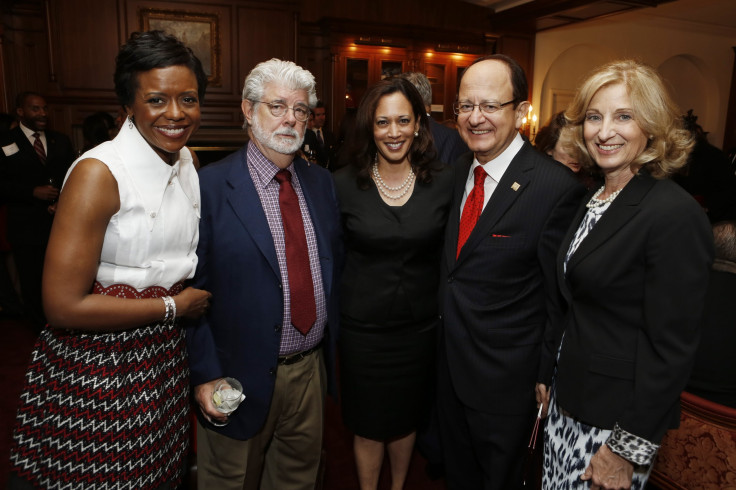USC’s Film School Wants To Make The Future Of Hollywood Less White — And Ready For VR

LOS ANGELES — When the camera pans over the crowd at the Academy Awards telecast on Sunday, it should provide a great look at the past and present of Hollywood. And like this year’s crop of Oscar nominees, it will be largely white. But if Hollywood is too homogenous in the here and now, what does its future hold? If George Lucas has his way, it will include a much more diverse spectrum of faces — and that’s just for starters.
“He’s been very passionate about underrepresented minority kids, particularly Latino and African-American,” C.L. Max Nikias, president of the University of Southern California, Lucas’ alma mater, told International Business Times. “And that’s why it’s no surprise his wife gave us $10 million recently for scholarships for underrepresented kids.”
Amid the groundswell of controversy this year over the lack of diversity at the Oscars, USC’s Annenberg School for Communication and Journalism just released a damning survey calling out Hollywood for its whiteness in front of and behind the camera, and even in the corner offices. But one corrective measure could be happening very close to home: USC’s School of Cinematic Arts, where Lucas is one of the largest trustees. The school’s core mission is one of preparing the next generation of moviemakers for a constantly evolving industry, whether that means striving to create an inclusive Hollywood that better reflects the audiences it serves or equipping students with the storytelling tools of tomorrow.
The dean of the cinema school, Elizabeth M. Daley, said beyond broadening Hollywood’s talent pool, the school — with active involvement from donors such as Lucas and Steven Spielberg — already has the tools for students to work natively in Imax and virtual reality, two areas the industry as a whole is betting heavily on. But whatever the medium, Daley said Lucas is constantly reminding student filmmakers to stay conscious of the influence their editorial decisions have, and that Hollywood should try to be a force for good.
“George is particularly concerned about whether people actually ask ethical questions,” Daley told IBT. “What am I saying? What values am I propagating? That’s very important to him.”

More and more films today are being released in large formats such as Imax, which take advantage of advances in special effects while allowing theaters to charge more per ticket. And that’s not just in mature film markets — China will soon have more Imax theaters than any country, and one of its media giants, the Dalian Wanda Group, is Imax’s biggest customer. And last month, Wanda reached a deal with Dolby Laboratories to install 100 of the Dolby Cinemas premium product in its theaters over the next five years.
USC has its own Imax lab to give its students a leg up. All the seats retract, and students can experiment with making images and see them immediately on the Imax screen, Daley said.
“The world they’ve lived in so much of their life has been the small screen, all the way down to the phone,” Daley said. “What are the implications of images that large — what does that do to the viewers? If I’m making animation for the large screen, what do I need to think about?”
Daley said these were the questions posed by the speaker at the lab’s dedication ceremony (none other than Steven Spielberg). And just as the school’s students have the ability to develop almost Imax-native content, they’re also getting a head start on working in a medium pretty much everyone thinks is the next big thing: virtual reality.
“It’s in its infancy and we have to begin to answer the question as to what the cinematic language of VR and AR [augmented reality] is going to be,” she said. “How do we think about the audience’s point of view? What’s a cut?”
But unlike most every other group of aspiring young filmmakers, USC students can start working on that now. The school partnered with VR company Jaunt on the Jaunt Cinematic Virtual Reality Lab, where students are currently making VR content and working out the early bugs well before many of their competitors can even get their hands on a VR camera.
“One of the things that we’re going to have to answer is what is the equivalent experience in VR to a cinematic experience,” Daley said. “And it could be partly linear, partly VR, partly animated.”
And failure to captivate audiences for the length of time of television shows feature films could ultimately doom VR to something better suited for one-off uses — or mostly nonentertainment stuff, such as surgery tutorials — than the future of showbiz.
“Were not technologists, we’re interested in content and audience experience,” Daley said. “We’re doing a lot of work with different companies on how to create content for it. Otherwise VR and AR will risk being a novelty, like home 3D.”

USC also has the biggest international student body of any school in the United States, and that geographic diversity extends to the film school. Daley said it undoubtedly gives students a leg up as far as understanding different storytelling techniques, which can be culture specific.
“There are different aesthetic underpinnings,” Daley said. “If you look at a film like ‘The Ice Storm’ — it’s not a Chinese film but [director Ang Lee is] Chinese. And there are things in that film that you think, if he was someone raised in Cleveland, Ohio, he might not have made the same film.”
And as the film industry is increasingly global, Nikias is doing his part to make sure USC is known to aspiring directors and creators, no matter where they come from. In October, he brought Disney chief executive Bob Iger to China as part of the USC Global Conference, an alumni networking and recruiting event. Iger’s wife, veteran broadcast journalist Willow Bay — also the director of the university’s Annenberg School of Journalism — interviewed him there. But Nikias said there’s one Hollywood name the school’s past and prospective Chinese students bring up more than anyone else.
“Everybody there notices the fact that Steven Spielberg’s a trustee,” he said. “And sometimes they suggest bringing Steven Spielberg to the conference.”
But the immediate future stateside is in young directors like Ryan Coogler, an African-American USC alum whom Daley credited with bringing several of his classmates along to work on his films “Fruitvale Station” and “Creed,” helping them break into Hollywood.
“One of the most inspiring things about students like Ryan is they have a very particular view, and translate it so people can see it,” she said.
And more of those particular perspectives surfacing in mainstream films — which probably means VR and Imax soon, too — could be one way to broaden Hollywood’s perspective. Or at least George Lucas seems to think so, but what does he know about movies?
© Copyright IBTimes 2024. All rights reserved.





















